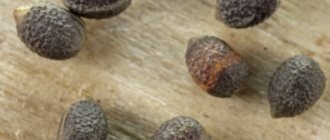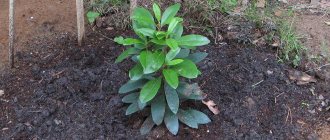Have you decided to transform your interior? Please note that today designers are concerned not only with how to renovate and furnish a room. No less important is the ability to decorate it with furniture and decorative elements so that it becomes elegant and stylish, filled with an atmosphere of comfort and individuality. Among various decorative finds, modern designers like to use special indoor plants - succulents. With their help, you can transform your interior yourself, without turning to a designer. Having learned about the propagation of succulents and the rules for caring for them, you will understand that these undemanding and original plants must be in your home.
What's so attractive about succulents?
Succulent garden
The name succulents, translated from Latin as “succulent”, was given to these plants due to their ability to store moisture for future use in their trunks and leaves. Therefore, they do not require special care and do not require frequent watering.
The variety of succulents is impressive. Tiny that can be grown in test tubes, and impressive in size, they look good in a home conservatory or just on a windowsill. Succulents stand out for their bizarre shape, surprising with the unexpected color of their leaves and unusual flowering.
It is believed that an indoor succulent shares useful energy with a person. It is no coincidence that they are recommended to be placed near a computer monitor; they have a beneficial effect on humans, some types have a healing effect.
Many people remember aloe; this is one of the varieties of succulents that our grandmothers considered mandatory to have on the windowsill. It is recommended to have a fat tree or “money tree” in your apartment or office to ensure financial well-being.
Some of the most popular succulents are also “living stone” and sedum, agave and various types of crassula, milkweed, echeveria and many other flowers.
Read more about Indoor succulents - varieties, care features
Let's find out in more detail how exotic indoor succulents are bred using leaves, plant cuttings or its seeds.
How to propagate succulents with leaves at home
Reading time: 2 minutes
Experienced flower growers claim that succulents do not require special care and are easy to propagate. It's true: Succulents are much easier to grow than many other plants. In this article we will tell you about small tricks that will make it easier to propagate Succulents.
Below we will talk about a method that many gardeners use: it will require leaves of a healthy plant . Of course, depending on the climate, our tips may work with varying degrees of effectiveness, but for many they work.
New roots emerging from a leaf
Find out how easy it is to propagate Succulents. To do this, you can use a plant you already have, as well as our step-by-step guide to growing Succulents from leaves at home!
How to separate a sheet
Everything will depend on the type and type of your Succulent . For example, most tender Sedums, as well as some Echeverias, can be propagated by either leaf or cuttings. On the other hand, Aeoniums are propagated only from apical cuttings. This is why you cannot breed them using leaves.
In other words, all varieties of Succulents are different, so if you don't know what works for you, just experiment! And in order to separate the leaf, simply twist it from the stem. The main thing is to make sure that there is nothing left on the stem. In fact, it's best to pull the leaf a little .
If you damage the leaf and part of it remains on the stem, most likely nothing will work out. Once done correctly, you will be able to see a clear outline at the base of the separated leaf.
Plant cuttings
To take succulent cuttings , you will need a cutting board, as well as sharp scissors or pruners. Cut a piece of the succulent stem just above the leaves. You can cut off the top of the plant, or simply cut off the cuttings. Both will germinate!
Dry the seedlings
After you have cut a cutting or leaf, it is very important to let it dry out a little. Depending on the amount of heat and intensity of sunlight, you may want to leave the seedling for a day or two to dry out.
A sprout growing from a leaf
If you don't do this, there will be too much moisture in the cutting or leaf, so it may rot the first time you water it. It is completely normal if after planting the leaf begins to shrink and shrink a little. As soon as you notice this, you need to water the seedling.
Watering
Mature succulents do not need daily watering, but leaves and cuttings need to be watered quite often. Lack of moisture will cause the seedlings to turn brown and die .
Best way to plant
If you are using leaves, place them on the surface of the soil , making sure that their ends do not touch the soil. Water whenever the soil becomes dry. You can use a sprayer to maintain moisture in the upper layers of the soil.
Some gardeners recommend placing the cut end of the leaf in the soil, but this may cause rot.
Unlike leaves, cuttings need to be planted in soil. Since these are practically mature Succulents, all they need is planting and watering . They will start to grow! Like leaves, cuttings should be watered whenever the soil is dry. This is what the leaves look like laid out on the substrate:
The cuttings and leaves will begin to grow new roots and take root within 3-4 weeks after planting.
If some of them die , don't worry - more than half will germinate! Some will grow very slowly, while others will have a lot of roots and no leaves at all. Each cutting grows differently, and it is completely normal if it fails to germinate!
As new plants develop, be sure to keep the roots covered with soil, otherwise they will dry out and the flower will stop growing.
In addition to the article, watch an educational video on growing Succulents from leaves:
Most Succulents will take at least a few months to grow into a mature plant, but some take about a year. In general, this is not a quick process , but it works! Try it, and very soon there will be a new addition to your collection of home flowers.
Source: https://flowerain.ru/cvety-v-dome/vidy-rasteniy/kaktusy-i-sukkulenty/kak-razmnozhit-sukkulenty.html
Using a propagation sheet
To start the type of plant you like, a leaf is enough. Propagation by leaves is a fairly simple and affordable method.
It is necessary to carefully consider the choice of leaf intended for propagation. It should be a strong, healthy leaf, without damage. You should not tear off or break off the leaf; to propagate it, you need to cut it off with a sharp knife, without leaving parts of it on the plant.
The cut leaf should not be placed in water; on the contrary, it must be kept in the air for a day or two so that the leaf dries out somewhat. The leaf needs to be dried on the surface of the soil in which it will grow. You don’t need to do anything special for rooting, you just need to turn the cut of the leaf towards the soil. Everything else will happen without our actions, the leaf will take root on its own!
Video “Propagation of succulents by leaves”
Planting in open ground
Gardeners sometimes use the "dry rooting" method in rocky flower beds , since the leaf propagation method works well for echeveria.
Step-by-step instruction
- Specially selected leaves are placed under the mother bush.
- They are laid with the edge or bottom side facing the substrate.
- Root formation occurs without contact with the soil.
- Next comes watering.
- The shoots of the roots themselves reach the soil cover.
- Rooting takes place within a month.
Cuttings of succulents
Another equally popular and simple method of propagating these exotic plants is cuttings.
The cuttings are also cut with a sharp knife and left to dry for a couple of days. You should definitely pay attention to the plant that gave the cutting. The resulting cut should be sprinkled with coal, which was previously crushed. In this case, before processing, you need to inspect the cut. If the plant is a species that secretes milky sap, the cut is first washed and then treated with charcoal.
Propagation by cuttings is a longer process. You can plant a cutting in the ground only after it has roots.
About rooting cuttings - more details
To root a succulent cutting, you can place it in a year or in a sand mixture. This method is the most suitable for cuttings of different types of euphorbia and crassula.
Rooting in water
Place the cutting in a container with clean, settled water (you can take boiled or distilled water), making sure that its lower part with the cut does not touch the bottom. At room temperature, the cuttings take root within 2-3 weeks. To create more favorable conditions, you can create greenhouse conditions for the plant. To do this, simply cover it with a clean and transparent plastic bag.
Subtleties of rooting in water:
- Treating the cutting with a growth stimulant before immersing it in liquid will make the process more effective.
- The container with the cuttings should be kept in a well-lit place at room temperature, adding water as necessary.
- If the cut rots, the cutting should be cut off and placed again in a container with clean water, after drying and treating with a growth stimulator.
Rooting in the sand
Sand mixture is usually used for rooting sansevieria. A cutting treated with a strengthening compound (Epin, Kornevin) is placed in prepared sand (sifted and fried in the oven or in a frying pan), then watered with warm water.
There is no need to deepen the cutting too much. 1.5 - 2.5 cm in depth is optimal for the plant.
During the process of rooting in sand, the cuttings are also kept in a warm and bright place.
Video “Propagation of succulents by cuttings”
We propagate succulents with children
Propagating succulents by shoots or children is another way to get a new plant. By removing shoots from the mother bush, the health of the crop increases and it better processes energy and nutrients.
The step-by-step procedure looks like this:
- Preparing an adult plant. The top layer of soil should be watered every day to soften it. This makes it easier to remove babies.
- Tool preparation . Take a sharp knife and immerse it in soapy water. Dip it in an alcohol-based solution, rinse and wipe.
- Protection. We wear thick gloves to protect our hands from thorns and germs. The remaining soil is removed from the children to study the condition of the roots. The most successful are considered to be shoots with a formed root system.
- Department . Using a sharp knife, remove the stem that connects the baby to the main plant. Then carefully remove the sprout from the soil without damaging the root system.
- Disembarkation. To plant cuttings, use nutritious soil. It is also important to provide a warm temperature to allow the succulent to establish itself without stress.
Aloe is often propagated by shoots, and the succulent Molodilo or Haworthia is also propagated. By following all the rules, you will be able to get a new and spectacular plant for your collection.
Another video that shows in detail the method of propagating succulents by children (shoots)
Propagation by seeds
Succulents can be grown from seeds. To do this, you will need soil consisting of fried sand and earth. In containers, the prepared mixture is covered with a thin sand layer (no more than 2 mm in thickness). The seeds are first dipped in a weak solution of potassium permanganate and left for 24 hours. The seeds treated in this way are placed in a thin layer of sand, which is spilled with the same solution before laying out. The container is covered with polyethylene, creating a “mini-greenhouse”. It is kept in a warm and bright place until sprouts appear. The germination period for different species ranges from 2 to 14 days. Diving can be done no earlier than a month after the sprouts appear. But the final transplant is possible only later; at least 6 months must pass before that.
How is it propagated by cuttings and leaves?
Cuttings are a popular propagation method at home. It can be grown in this way both in spring and summer. Side shoots located on the main stem are ideal for propagation. Propagation by leaves allows you to rejuvenate an aged flower and give it strength for subsequent development.
We invite you to watch a video about the characteristics of aloe propagation:
How to prepare a cutting without roots or a leaf?
For cuttings, choose well-formed straight shoots. Their length should be about 10 cm. The presence of 6 or more leaves is a prerequisite for effective reproduction.
The following tips will help you prepare your escape correctly:
- Cutting. Perform with a sharp knife. Avoid damage to nearby growing shoots and leaves. The instrument must be disinfected in a dark solution of potassium permanganate.
- Accommodation. Place the prepared shoot in a closet and leave it like that for 5-7 days. The cut should dry and become covered with a film. Monitor the humidity level during storage: the optimal value is 50%.
- Disinfection. Treat clay containers for cuttings with superphosphate solution, plastic containers with soapy water, and bake ceramic containers in the oven for 15 minutes.
If you decide to propagate by leaves, you should choose well-developed, strong and healthy planting material. Sheet size – from 8 cm.
- Cut the leaves only with a clean, sharp tool from the base of the main stem. The cut should be inclined.
- Place the prepared material in a dry cloth and leave it like that for 1-2 days. The cut should dry well and be covered with a film.
How to plant?
The cutting process is as follows:
- Pour 3/4 of the soil mixture into the container, consisting of equal parts:
- peat;
sand;
- ash;
- perlite;
- crumbs of brick or small crushed stone;
- ordinary land.
- Treat the cut of the cutting with charcoal.
- Bury it 2 cm into the soil. The gap between shoots should be 4-5 cm.
- Sprinkle the soil surface with gravel to secure the plantings.
- Place the container on a windowsill with plenty of sunlight. Maintain temperature regime – +20-+25°C.
- Subsequent care consists of timely watering. Stagnation of water is unacceptable.
Fill the remaining volume with moistened sand.
After 4 weeks, the root system will form. New plants can be planted in separate pots.
Propagation by leaves includes the following stages:
- Sprinkle the cut with charcoal powder. You can replace the material with activated carbon.
- Fill the container with soil mixture from:
- garden soil;
sand;
- vermiculite.
- Deepen the leaves into the soil 3 cm.
- Place the plantings in a warm room filled with plenty of sunlight.
Moisturize well.
Many gardeners do not dig in the leaves, but simply lay them out on the surface of the ground. The roots that appear will “go” into the soil themselves.
Young plants require systematic watering. When the sprouts are well formed, they can be planted in separate pots.
Planting succulents
To ensure the successful development of the plant, you need to follow simple planting rules.
Choosing a pot
Planting fancy flowers starts with deciding which succulent pot will work best. When choosing a container for planting, it is necessary to determine how the flower is supposed to be grown, whether it will be a single planting or a composition of flowers will be created in a pot. In this regard, a more or less spacious pot is selected. Planting in a flat flower container is also popular. You should not choose a pot that is too large. In this case, the growth of the plant will be slowed down: the succulents first “master” the planting pot with their roots and only then use the energy to develop the upper, above-ground part of the plant.
When choosing a container for planting, the gardener independently gives preference to the material from which it is made (plastic or clay), as well as the shape of the pot. A mandatory requirement for any planting container is the presence of a drainage hole in the bottom of the pot.
Video “Choosing a pot for succulents”
Soil preparation
The next step is to prepare succulent-friendly soil. Flower and garden stores sell soil for indoor succulents. In addition to this soil, it is necessary to prepare river sand and expanded clay for drainage.
Fill the pot in the following sequence: first layer - drainage, 2nd layer - wet soil mixture, 3-1 layer - sand.
Landing
The succulent is planted in soil mixture. The sprout is carefully placed in the pot without damaging the roots of the flower. The soil mixture should cover the roots up to the root collar, which should be in the sand layer. This will keep the plant from rotting.
Adaptation
An important moment in the life of a plant is the adaptation period and care after reproduction. For 1-1.5 weeks, the plant is protected from direct sunlight to avoid burns and is not watered. The moisture content of the soil mixture will be sufficient, but its excess can lead to rotting.
Video “Soil for succulents”
Growing from seeds
Sowing seeds is the most common type of growing plants for many years. Succulent lovers probably want to purchase something new for their collection, something special, rare, unusual, at an affordable price.
For this, sowing seeds are often used, which can now be easily purchased in online stores such as “Cactus” or Aliexpress (review of seeds from Aliexpress), having received new friends by mail. Having learned the basic principles of sowing and care, it is quite possible to grow many healthy, strong plants yourself at home.
It will be very interesting for you to watch the germination and development of the seeds of these wonderful plants. You will be able to select for yourself the most interesting specimens of seedlings, thereby expanding the collection.
How to plant and grow succulents from seeds at home? Our recommendations and photos will help you in this exciting activity. It is necessary to take into account a number of features such as:
Selecting a container for sowing
You will need shallow (about 50mm high) plastic containers with holes at the bottom and transparent lids. You can make one greenhouse from a large box with a lid or cover it with plastic wrap and place several small boxes with substrate and seeds there. Stores sell suitable greenhouses, but you can use a regular plastic container, the main thing is not to forget about the holes in the bottom of the container.
The soil
- Regular mixtures containing a coarse mineral base, such as sand, agroperlite, fine gravel, are suitable; you can also add a little crushed or granulated coal.
- You can purchase a universal peat filler - slightly acidic humus and add sand, crushed coal, and perlite to it in equal proportions.
- To prepare seeding soil, it is better to use high-quality ingredients purchased in specialized stores. If you want to take sand, gravel or coal from a garden plot or forest, you need to thoroughly treat everything with a disinfectant solution, steam it or fry it.
Also read: Kalanchoe flower: photo and care at home
If the seeds are large, they can be sown in granite chips or gravel and sand. Sowing seeds in purely mineral substrates reduces the likelihood of seedlings dying from rotting in the first couple of months of their life. But in this case, the seedlings need to be watered almost every day, adding special fertilizers.
Succulents such as Aloe, Haworthia and Gasteria are great to sow in clean perlite. Perlite has high moisture capacity and breathability. But we should also not forget that such a substrate does not contain nutrients. Perlite should be well moistened with water before sowing.
Sowing seeds
To distribute the seeds evenly, it is recommended to take a thick sheet of paper, bend it in half, and pour the seeds into it, then tapping it with a thin stick or needle, scatter it into the substrate. Changes are sown on top of the substrate, covered on top with a mixture of earth or a small layer of coarse sand, about 2 mm. The sprinkled layer should not be thicker than the size of the seed itself, therefore, if the seeds are very small, for example, like those of ficus, then it is better not to sprinkle them at all.
Don't forget to make plastic tags indicating the type of your plants, thanks to which you can always find out the name of your friend and clarify recommendations for his care.
We water the top with a small amount of filtered water at room temperature (you need to water it with a spray bottle), using the spraying method, so as not to wash away the soil with the seeds, and to prevent the seeds from penetrating deep into the ground. Next, cover with a lid or film. You need to cover the greenhouse before the seeds sprout and after, until the plants get a little stronger and reach a size of 1-2 cm. Then we gradually stop covering.
Seed germination time varies among different species. Thus, seeds of the families Agavaceae and Liliaceae germinate faster, while Apocynaceae and Asclepiadacea have a long germination time, sometimes up to three months.
All this time, the seeds must be kept in moist soil, and only after 60-90 days will they begin to hatch. Therefore, you should not stop watering, thinking that the seeds were bad. Higher germination is observed in freshly harvested seeds.
Sowing care
To get maximum germination, you need to take into account factors such as temperature, lighting and watering:
- The optimal temperature for seeds during the day is +20 – 26 degrees; the greenhouse should not be in the open sun. In summer, temperatures up to + 30 degrees during the day and + 18-20 degrees at night are suitable. At night, the seeds should rest from daytime temperatures. Drafts should also be avoided.
Also read: Fungicides and fertilizers suitable for cacti and succulents
Haworthia and Dioscorea seeds require a temperature of +18-20 degrees for germination. It is better to sow them in winter or early spring, so that the seeds germinate in optimal conditions, and in the summer they can gain strength and get stronger.
If you want to sow seeds all year round, you will need to install a greenhouse and special lighting.
- lighting is required, but you should avoid direct sunlight, which can harm delicate, fragile plants. If young seedlings do not have time to grow stronger over the summer and reach a size suitable for comfortable life in winter (2-5cm), it is recommended to use phytolamps to extend the growing season.
- Watering the substrate should be regular; the soil should not be allowed to dry out completely, but the water should not stagnate. It is best to water little by little as the top layer dries out and sometimes leave it for a couple of days to dry out the lower layers of soil. Particular attention to watering is required in the first year of life. For the first couple of months, the soil should not be allowed to dry out for a day or more. Then you can gradually accustom the young plant to dry soil. In summer we water more often, in winter a little less.
As they grow, you can plant the seedlings in pots. A plant 2-5 cm high, which has several stronger leaves, is ready for replanting (Read about how to replant a succulent in this article). The amount of water for watering one independent plant is approximately 3-4 ml. It is convenient to use a syringe for these purposes.
Grown plants ready for transplanting. Photo taken from the site https://raritet-plants.ru/seed-propagation/
Fertilization and disease prevention
For medicinal purposes and for the prevention of seedling diseases, fungicides (Vitaros, Maxim) can be used. They must be diluted following the instructions. Insecticides are also used, but only liquid, low concentrations. If you use nutritious soils, then additional fertilizers are not needed in the first six months. If the soil is completely organic, special fertilizers for cacti and succulents are suitable, strictly according to the instructions.
Caring for Succulents
Succulents are an undemanding houseplant. But you can’t do without following the basic rules of care.
- Watering
These indoor flowers do not need abundant watering. The frequency of watering depends on the time of year. In winter, plants are watered less often; succulents at room temperature are watered no more often, 1-2 times a month. Starting in spring, watering becomes more frequent: every 7-10 days.
- Fertilizer
Succulents respond well to weak solutions of phosphorus-potassium fertilizers without nitrogen or with a minimal amount of it. Frequent application of fertilizers - 1-2 times a month.
The industry also offers special complex fertilizers for succulents. When using them, specific instructions for use must be followed.
By following these simple rules for propagating, planting and caring for flowers, you can do more than just start succulents at home. An original composition of beautiful and unusual plants will become a real interior decoration.











